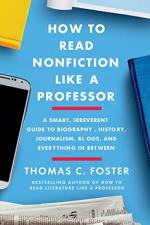
|
| Name: _________________________ | Period: ___________________ |
This quiz consists of 5 multiple choice and 5 short answer questions through Section 4: Chapter 13,"On the Stump" through Chapter 15, "Reading Internet Sources".
Multiple Choice Questions
1. In Chapter 8, "Bringing the News," Foster makes the point that during the Nassar scandal, the Lansing State Journal did what?
(a) Covered the breaking news and then allowed local magazines to take over coverage.
(b) Covered the scandal primarily as a sports story.
(c) Devoted its resources fully to the story and stuck with it over a long period of time.
(d) Initially helped Michigan State University cover up the story but later pivoted to full coverage.
2. In Chapter 7, "All in How You Look at Things," what does Foster cite as one of the main reasons that Americans have historically trusted the news media?
(a) Journalists' willingness to admit mistakes.
(b) Journalists' willingness to admit bias.
(c) The tendency of editors to insist on multiple sources.
(d) The strict editorial control of content.
3. Based on Chapter 14, "The Universe of Ideas/Ideas of the Universe," what would Foster call a journalist writing a general survey of the field of string theory?
(a) Expert testimony.
(b) Interrogation of text.
(c) Journalistic compilation.
(d) Amateur profiles.
4. In Chapter 10, "From the Inside Out," why does Foster not capitalize the name of bell hooks?
(a) He is showing how little he values her work.
(b) It is a name she herself rejected.
(c) He is respecting hooks's wishes.
(d) It is a pseudonym.
5. In Chapter 14, "The Universe of Ideas/Ideas of the Universe," what does Foster say is true about contemporary America?
(a) Americans are educated to read science critically.
(b) America is the most scientifically advanced nation on earth.
(c) Many Americans are antiscientific.
(d) There is not much great science writing going on in America today.
Short Answer Questions
1. In Chapter 7, "All in How You Look at Things," Foster says that which type of nonfiction is usually better off starting at the beginning chronologically?
2. In Chapter 12, "Life from the Inside," why does Foster think Ambrose chose Merriwether Lewis's perspective for his history Undaunted Courage?
3. In Chapter 2, "The Ecology of the Nonfiction Biosphere," what problem does Foster say can arise if readers do not understand the forms of writing?
4. In Chapter 12, "Life from the Inside," Foster says that an author of a history about long-ago events is not really so much a reporter as a what?
5. "Flu cases are 100% higher this year" is an example of what problematic use of data discussed by Foster in "Interrogating the Text"?
|
This section contains 459 words (approx. 2 pages at 300 words per page) |

|




